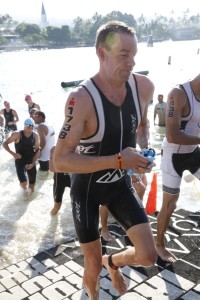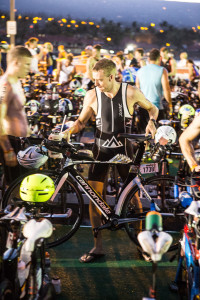Pacific Quest is supporting Mike Sullivan on his “2016 Road to Kona.” Yes, you heard correctly, Mike is taking another stab at the World Championship Ironman, assuming he is selected to participate through the Hawaii Resident Lottery on May 5, 2016. Mike will share insights and perspectives throughout his 2016 races and training, and drawing parallels between the mind-body connection and wellness – important themes at Pacific Quest.
In his first two posts, Mike shared his insights before and after the Hilo Marathon. With this third installment, Mike parallels navigating transitions in racing, wilderness therapy, and life.
By Mike Sullivan, MA, LMHC
Alumni and Family Services Director
“Ooooh…. Yikes, my body feels so sluggish,” I say to myself as I get off my bicycle and start running. There is that familiar feeling -my feet are heavy, my legs feel tight, and my run pace starts out slow motion. The transition is uncomfortable, as my body begins to reroute blood flow from my cycling muscles into my running muscles. In triathlon training, workouts that combine two sports is a called a “brick.” It is critical to practice brick workouts, as it not only trains the physical body to adapt to shifting from one sport to another, but it also gives the athlete a chance to master transition itself – navigating mental and emotional challenges that are inherent in transition. The lessons of transition mastery in triathlon parallel those in life, and importantly, are equivalent to the transition practice that students at Pacific Quest encounter regularly.
Triathlons consists of racing consecutive swimming, cycling, and running sections, and triathletes refer to the two transitions during a race as T1 and T2. T1 is the point during the race where the athlete exits the swim and transitions onto the bicycle. T2 is where the athlete finishes the bike leg, and transitions into the final stretch of the race, the run. While an athlete may be incredibly skilled at swimming, cycling, and running, the winning athlete will have mastered the transitions as well. They are integral to the race and should not be overlooked. In preparing for the Kona Half Ironman this coming June, I am especially attentive to aspects of T1 and T2, including organization, techniques, and anticipating discomfort. Practicing transitions cannot be overstated.
Similar to what I discussed in terms of preparation for the Hilo Marathon last month, organization is a critical skill to triathlon transition. One should lay out their cycling and running equipment in an organized fashion, being meticulous about the placement of equipment, as each piece has its place in the whole. Also sticking to an orderly routine is a must- this is more efficient as it conserves mental and emotional energy. The more organized and methodical the athlete is, the more smooth the transition is.
Athlete’s are sponges for new skills and must remain open to learning valuable techniques. For instance, in my first triathlon it hadn’t occurred to me to roll my bicycle socks into little donuts. This technique allows the athlete to simply roll the socks onto each foot when you get out of the water. With wet feet, it is much more time consuming and challenging to pull socks over your feet the way you would normally. I lost valuable time and felt frustrated and out of balance trying to pull socks over wet feet. Once I learned the donut technique, my next T1 went more smoothly and I felt more confident and level headed as I entered the cycling section of the race. This is a small example of a much larger lesson- learn techniques to be more successful each time.
Lastly, I will highlight anticipating discomfort. In every “brick” workout, I am getting used to the painful discomfort of shifting gears from one sport to another. This allows me to adapt to the discomfort and creates a higher tolerance. While it is physically grueling to transition, it takes a mental toll on the athlete. The physical and mental are inextricably linked. If the athlete allows the discomfort to permeate his mental and emotional focus, the athlete will suffer, and so will performance.
These transitions, T1 and T2, provide relevant lessons for life. Every person encounters transitions life ranging from small day to day transitions to major life transitions. How do people navigate transitions in life? What skills and metaphors from triathlon are applicable? How do these parallel the transitions that Pacific Quest students practice?
At Pacific Quest, adolescent and young adult students graduate through “stages of growth,” while in the program. They move from stage to stage, and with each successive stage, the students must transition to a new physical camp, with increased responsibilities and challenges. This provides a fantastic medium for internalizing valuable lessons for navigating transition. The students learn important tools related to organization (taking care of their belongings and keeping them orderly), techniques for a successful transition (visualizing obstacles, affirming strengths), and anticipating discomfort. The transitions serve as valuable practice for transitions they will encounter in life, whether it is a simple as some of the daily transitions one encounters (shifting gears between home and school) to larger life transitions (starting at a new school, moving, family shifts).
As the Kona Half Ironman approaches, I look forward to employing these tools in race preparation, and on race day itself. Track me live during the race on June 4th by following the link for the Ironman Tracker through the PEAK Self website. With each race, I am able to review performance, and identify what went well and areas where I can improve. I look forward to following up on this blog post with insights following the race, and highlight important lessons learned!

